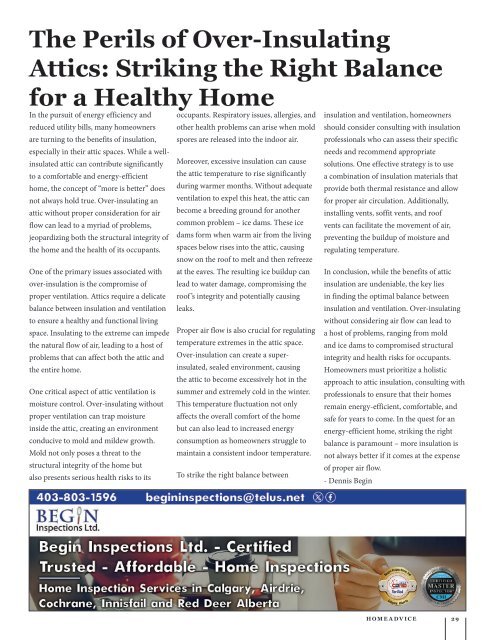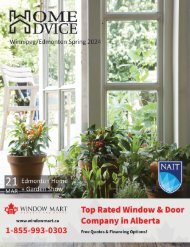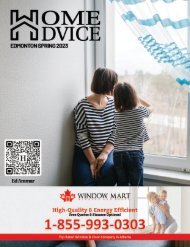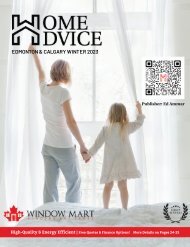Calgary Winter 2024
Home and Garden
Home and Garden
Create successful ePaper yourself
Turn your PDF publications into a flip-book with our unique Google optimized e-Paper software.
The Perils of Over-Insulating<br />
Attics: Striking the Right Balance<br />
for a Healthy Home<br />
In the pursuit of energy efficiency and<br />
reduced utility bills, many homeowners<br />
are turning to the benefits of insulation,<br />
especially in their attic spaces. While a wellinsulated<br />
attic can contribute significantly<br />
to a comfortable and energy-efficient<br />
home, the concept of “more is better” does<br />
not always hold true. Over-insulating an<br />
attic without proper consideration for air<br />
flow can lead to a myriad of problems,<br />
jeopardizing both the structural integrity of<br />
the home and the health of its occupants.<br />
One of the primary issues associated with<br />
over-insulation is the compromise of<br />
proper ventilation. Attics require a delicate<br />
balance between insulation and ventilation<br />
to ensure a healthy and functional living<br />
space. Insulating to the extreme can impede<br />
the natural flow of air, leading to a host of<br />
problems that can affect both the attic and<br />
the entire home.<br />
One critical aspect of attic ventilation is<br />
moisture control. Over-insulating without<br />
proper ventilation can trap moisture<br />
inside the attic, creating an environment<br />
conducive to mold and mildew growth.<br />
Mold not only poses a threat to the<br />
structural integrity of the home but<br />
also presents serious health risks to its<br />
occupants. Respiratory issues, allergies, and<br />
other health problems can arise when mold<br />
spores are released into the indoor air.<br />
Moreover, excessive insulation can cause<br />
the attic temperature to rise significantly<br />
during warmer months. Without adequate<br />
ventilation to expel this heat, the attic can<br />
become a breeding ground for another<br />
common problem – ice dams. These ice<br />
dams form when warm air from the living<br />
spaces below rises into the attic, causing<br />
snow on the roof to melt and then refreeze<br />
at the eaves. The resulting ice buildup can<br />
lead to water damage, compromising the<br />
roof ’s integrity and potentially causing<br />
leaks.<br />
Proper air flow is also crucial for regulating<br />
temperature extremes in the attic space.<br />
Over-insulation can create a superinsulated,<br />
sealed environment, causing<br />
the attic to become excessively hot in the<br />
summer and extremely cold in the winter.<br />
This temperature fluctuation not only<br />
affects the overall comfort of the home<br />
but can also lead to increased energy<br />
consumption as homeowners struggle to<br />
maintain a consistent indoor temperature.<br />
To strike the right balance between<br />
insulation and ventilation, homeowners<br />
should consider consulting with insulation<br />
professionals who can assess their specific<br />
needs and recommend appropriate<br />
solutions. One effective strategy is to use<br />
a combination of insulation materials that<br />
provide both thermal resistance and allow<br />
for proper air circulation. Additionally,<br />
installing vents, soffit vents, and roof<br />
vents can facilitate the movement of air,<br />
preventing the buildup of moisture and<br />
regulating temperature.<br />
In conclusion, while the benefits of attic<br />
insulation are undeniable, the key lies<br />
in finding the optimal balance between<br />
insulation and ventilation. Over-insulating<br />
without considering air flow can lead to<br />
a host of problems, ranging from mold<br />
and ice dams to compromised structural<br />
integrity and health risks for occupants.<br />
Homeowners must prioritize a holistic<br />
approach to attic insulation, consulting with<br />
professionals to ensure that their homes<br />
remain energy-efficient, comfortable, and<br />
safe for years to come. In the quest for an<br />
energy-efficient home, striking the right<br />
balance is paramount – more insulation is<br />
not always better if it comes at the expense<br />
of proper air flow.<br />
- Dennis Begin<br />
HOMEADVICE<br />
29

















